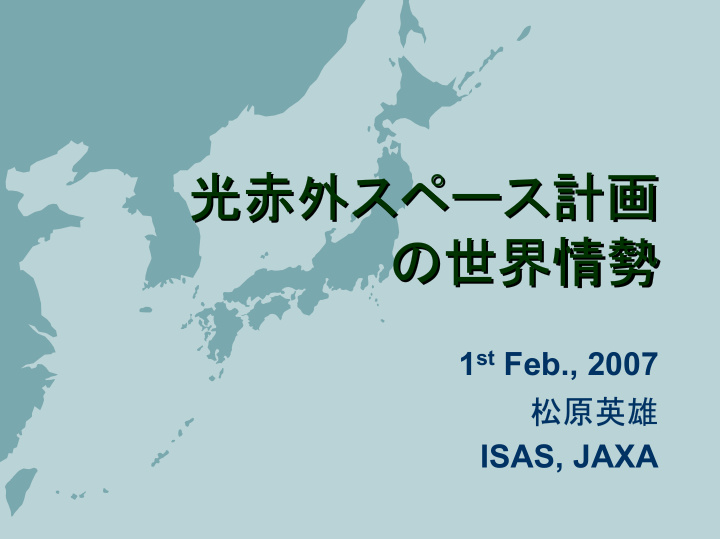



光赤外スペース計画 光赤外スペース計画 の世界情勢 の世界情勢 1 st Feb., 2007 松原英雄 ISAS, JAXA
Astronomy Satelites(ESA Satelites(ESA related) related) Astronomy
Spitzer and Akari Akari Spitzer and are on orbit are on orbit � Spitzer ( 2003 ) � Akari ( 2006 ) – 85cm 、 <5.5K – 70cm 、 <6K – 3 - 160 µ m – 2 - 160 µ m
WISE WISE (Wide- -field field (Wide Infrared Survey Infrared Survey Explorer) Explorer) � Dedicated for Survey – Mid-IR version of 2MASS survey � Diameter: 0.5m � Wavelength: 3.5 – 23 µ m � Spatial resolution: 5” � Launch: 2009 Orbit: polar 600km – NASA MIDEX selected (Aug. 2004) – Life: 6 months
SNAP SNAP (SuperNovae SuperNovae / Acceleration Probe) / Acceleration Probe) ( � Specific purpose – Cosmological constant / dark energy � Diameter : 2.0m � Wavelength: 0.35 – 1.7 µ m � FOV: 35arcmin 2 x 2 (opt & NIR) � Orbit: “Prometheus” orbit � Launch: 20?? – NASA, DOE funds have been approved by Council – Life : more than 2.5 years
Next Generation IR Space Next Generation IR Space Observatories Observatories � Hershel ( 2008? ) � JWST ( 2013? ) � SPICA ( 2015? ) – 3.5m 、 70K – 6.5m 、 30K – 3.5m 、< 5K – 60~670 µ m – 0.6~27 µ m – 5~200 µ m main
S- -E L2 E L2 S JWST Hershel/Planck SPICA GAIA …
Herschel Space Observatory Herschel Space Observatory � ESA � Lauch: 2008?, 3 years life � Telescope: 3.5m, 80K � Wavelength: 60-670 µ m � PACS ( λ =60-210 µ m) – Imaging: 1’.75x3’.5 – Spectroscopy: R=2000 � SPIRE( λ =200-600 µ m) – Imaging: 4’x8’ – Spectroscopy: R=100-1000 � HIFI
PLANCK PLANCK � ESA � Launch: 2008? (together with Herschel) � 1.5 m telescope � CMB anisotropy over the whole sky (in 15 months) – Similar (better?) angular resolution with WMAP(~0.2deg) – wider wavelength coverage than WMAP, 0.3 – 10mm
GAIA GAIA � ESA’s space astrometry mission at optical � All-sky, 10 µ as � Launch: – December 2011 (Soyuz rocket from French Guiana). � Status: – Under development, with EADS Astrium SAS as prime contractor. � Orbit : S-E L2
JWST JWST (James Webb Space Telescope) (James Webb Space Telescope) � General purpose space telescope � Diameter: 6.5m, T<50K � Launch: 2013?, ~5 year life � Wavelength: 0.6-10 µ m – NIRCAM • 0.6-5 µ m, 2’.3x4’.6x2, R=100 tunable filter – NIRSPEC • 0.6-5 µ m, 3’x3’ MOS with micro shutter (or IFU) • Spectra of 100 objects per exposure – MIRI • 5-27 µ m, 1’.5x1’.5 • R=100, 1500-3000 spectroscopy
SPICA SPICA Space Infrared telescope Space Infrared telescope for Cosmology and Astrophysics for Cosmology and Astrophysics � Telescope: 3.5m, 4.5 K – JWST(20-40K), HSO(80K) � Core λ : 5-200 μ m – Complementary to JWST (Opt-NIR), HSO (Sub-mm) � Orbit: Sun-Earth L2 Halo � Warm Launch, Cooling L4 on Orbit � Total Weight: 2.6 t L3 L1 L2 � Launch: 2015? by HIIA Sun Earth � ~5 year life L5
米国の状況 米国の状況
SAFIR SAFIR � (was) included in NASA space science road map � 10 m telescope cooled to 4K � Wavelength: 15-600 µ m – Natural-background-limited sensitivity � Diffraction-limited angular resolution at ~40 µ m
SPIRIT & SPECS SPIRIT & SPECS � FIR & Submm space interferometer – 1km maximum baseline � Sensitivity comparable to that of SAFIR � Far better angular resolution than SAFIR
Angular resolution of Angular resolution of SAFIR, SPIRIT, SPECS SAFIR, SPIRIT, SPECS
米国のスペース天文学予算状況 米国のスペース天文学予算状況 � アメリカのスペース天文学の予算は年間 1500M $程度。 – このうち、 2/3 が JWST と HST (サービスミッション)。他を 大きく圧迫してる。 – その結果、 TPF 、 SIM の予算がほとんどゼロ。 � アメリカの単一鏡 SAFIR (SPICA の拡大版)、ス ペース干渉計計画 SPIRIT は、実現のめどがまった くなし・・ – SPICA への参加? 2008年の MIDEX への応募?
NASA Priority Table (1) NASA Priority Table (1)
NASA Priority table (2) NASA Priority table (2)
欧州の状況 欧州の状況
Cosmic Cosmic Vision Vision 2015- -2025 2025 2015 � ESA のスペース科学 将来計画 � 2004年4月に色々 な提案(全部で151) を募り、2004年9月 のパリでの WS で選 択。 � 4つの科学的課題を 設定、それぞれにつ いて将来ミッションを 検討。 http://www.esa.int/esaSC/SEMA7J2IU7E_index_0.html
What are the conditions for planetary formation What are the conditions for planetary formation and the emergence of life? and the emergence of life?
How does the solar system work? How does the solar system work?
What are the fundamental physical laws What are the fundamental physical laws of the Universe? of the Universe?
How did the Universe originate How did the Universe originate and what is it made of? and what is it made of?
ESA Cosmic Vision のスケジュール ESA Cosmic Vision のスケジュール L (6億ユーロ)、 M (3億ユーロ)の公募開始 2007年 2月頃 � 2007年 6月頃 公募締め切り � L 3件、 M 3件程度に絞る 2007年10月頃 � Herschel 打上げ) � (2008年 M を2件に絞る 2009年 � M を1件に絞ってスタート 2011年 � L を2件に絞る � L を1件に絞ってスタート 2015年 � M の打ち上げ 2017年 � L の打ち上げ 2020年以降 � � 平行して、2010年頃には次回の公募があるかもしれない � ESA の予算が大変厳しい。2020年すぎまでに、 M と L を1件ずつしか実 現できない – この枠を X 線や惑星、 Darwin 、 LISA (重力波)と赤外で争う。 – ESI on SPICA を M の枠で応募 – FIRI を L の枠で応募
Recommend
More recommend